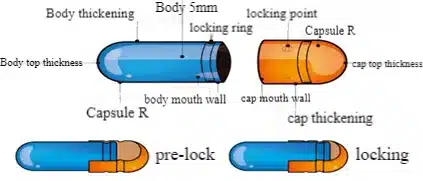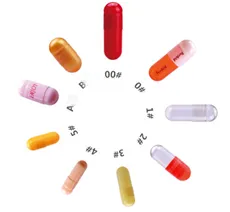Learning capsule types, capsule filling processes, materials like gelatin and HPMC, and the benefits of capsules in drug delivery systems.
What are capsules?

Purpose of Capsule Shells
In professional terminology, capsule-shaped medicinal dosage forms as capsules. Simply put, these are solid preparations made by filling the active pharmaceutical ingredient (API) or suitable excipients (additives) into an empty capsule shell or sealing them in a soft capsule material.
Capsules can hold solid drugs, protecting them from moisture, air, and light while also masking the active ingredients’ bitterness, unpleasant odors, or other undesirable tastes.
The notable difference between the manufacturing processes of capsules and tablets is that the powder in capsules is generally not subjected to significant compression forces. In other words, unlike the tabletting process, the capsule filling process does not alter the dissolution characteristics of the powder. As a result, the powder and the capsule shell impact the capsule’s quality characteristics.
The supplier provides the capsule shell, while the processing steps determine the quality attributes of the powder before filling. As a result, the operational parameters of the capsule filling process do not significantly affect the final product’s quality attributes. To some extent, the properties of the capsule shell itself determine the other product attributes, aside from the powder characteristics.
The goal of the capsule shell is for it to “not interfere with drug release in vitro, nor affect drug absorption in vivo”. This primarily depends on whether the capsule shell can disintegrate quickly.
Appearance of Capsule Shells
Capsule shells consist of two overlapping parts (the cap and the body). Each part has a rounded, closed end and an open end. The larger-diameter capsule cap fits over the smaller-diameter capsule body, providing good sealing when locked.

Size of Capsule Shells
Eight different sizes of capsule shells are available. The most common ones are 00#, 0#, 1#, 2#, 3#, and 4#. The smaller the capsule number, the larger the capacity.

Below is a table with all the specifics:
| 00# | 0# | 1# | 2# | 3# | 4# | ||
| Cap length (mm) | 11.6 | 10.8 | 9.8 | 9.0 | 8.1 | 7.1 | |
| Body length (mm) | 19.8 | 18.4 | 16.4 | 15.4 | 13.4 | 12.1 | |
| Cap thickness (mm) | 0.11 | 0.11 | 0.1 | 0.1 | 0.095 | 0.095 | |
| Body thickness (mm) | 0.11 | 0.11 | 0.11 | 0.095 | 0.095 | 0.095 | |
| Cap diameter (mm) | 8.48 | 7.58 | 6.82 | 6.35 | 5.86 | 5.33 | |
| Body diameter (mm) | 8.15 | 7.34 | 6.61 | 6.07 | 5.59 | 5.06 | |
| Locked length (mm) | 23.3 | 21.2 | 19 | 17.5 | 15.5 | 13.9 | |
| Weight (mg) | 122 | 97 | 77 | 62 | 49 | 39 | |
| Volume (ml) | 0.95 | 0.68 | 0.5 | 0.37 | 0.3 | 0.21 | |
| Fill weight (mg) | Powder density 0.66 g/ml | 570 | 408 | 300 | 222 | 180 | 126 |
| Powder density 0.8 g/ml | 760 | 544 | 400 | 296 | 240 | 168 | |
| Powder density 1.0 g/ml | 950 | 680 | 500 | 370 | 300 | 210 | |
| Powder density 1.2 g/ml | 1140 | 816 | 600 | 444 | 360 | 252 | |
Capsule Parameters
Classification of Empty Capsules
The most common materials used for empty capsule shells are gelatin and hydroxypropyl methylcellulose (HPMC). The following is a comparison of gelatin capsules and HPMC capsules:
| Gelatin Capsule Shell | HPMC Capsule Shell | |
| Category | Animal-derived Capsule Shell | Plant-derived capsule shell |
| Main Ingredients | Gelatin (from animal bones and skin) + water | Safe and reliable, listed in multiple pharmacopoeias |
| Manufacturing Process | Hydroxypropyl methylcellulose (from cotton linter, wood pulp) + water | |
| Moisture Content | 12.5%-17.5% | 4%-7% |
| Solubility | Swells but does not dissolve in 25°C cold water | Gradually dissolves in 25°C cold water |
| Brittleness | NONE | Fewer than 5 brittle capsules per 50 |
| Safety | Safe and reliable, listed in multiple pharmacopeias | Risk of preservative overuse, BSE (mad cow disease) concerns |
Capsule Parameters
Capsule Filling Machines
During the capsule filling process, different machines and equipment may be used. Different filling machines don’t affect the capsule quality. Generally, a small-scale capsule filling can use manual filling, including hand-in and capsule filling boards, semi-automatic capsule filling machines, or small-scale fully automatic capsule filling machines. Large-scale capsule filling often uses fully automatic capsule filling machines.
Manual Filling
There are generally two approaches for manual filling:
Weigh the empty capsule shell first, then separate the capsule body and cap, add the theoretical weight of the contents, pre-lock the capsule body and cap, weigh and adjust the weight, and once acceptable, fully lock the capsule body and cap.
Weigh a certain amount of content, add a portion to the capsule body, tamp it down, and then add the remaining contents. After filling, lock the capsule body and cap. The first method is the gross weight method, while the second is the net weight method, with a typical production capacity of 30–90 capsules per hour.
It is also possible to use a capsule filling board to fill capsules. First, manually separate the capsule body and cap, then use the filling board to fill and lock the capsule. The quantitative principle of this tool is to adjust the filling height using screws around the edges. Assuming the density remains constant, the weight is adjustable. Typically, there is significant weight variation at the corners. It can adjust the filling weight in the corner capsules to minimize overall weight variation.
Semi-Automatic Capsule Filling Machine
A semi-automatic capsule filling machine always uses three steps, from capsule body-cap separation and content filling to capsule sealing. The principle of body-cap separation is the same as manual filling, using the auger filling method. The rotating auger presses the powder through the feeder into the open capsule body in the rotating ring under the hopper. The filled volume controls the filling weight.
Fully Automatic Capsule Filling Machine
Dosing Tube-Type Capsule Filling Machine
The material is added to the powder hopper, with a dosing disc installed at the bottom. The dosing disc has six uniformly distributed dosing holes, and with each 60° mechanical rotation, the dosing tube gradually compresses the powder in five steps. After the fifth compression, a scraper isolates the powder from the dosing plate. When the dosing disc rotates to the final hole, the powder column is pushed into the capsule body, completing the filling process.
Three factors control the filled amount:
- The density of the powder and the thickness of the dosing disc,
- The compression force applied by the dosing tube during each step,
- The height of the powder in the powder hopper.
Piston-Type Capsule Filling Machine
The device comprises a hollow metal dosing tube and a spring-loaded adjustable piston. The piston moves up and down to adjust the volume, thereby controlling the powder dose.
The dosing device is inserted into the powder bed as the machine operates. The material in the powder hopper remains at a constant height. As the dosing device moves to the bottom of the powder bed, it pre-compresses the powder.
Then, the piston continues to compress the powder, forming a powder column of sufficient strength. After the dosing device exits the powder bed, it aligns with the open capsule body. The piston moves down to the bottom of the dosing tube, pushing the powder column into the capsule body, completing the filling process.
Three factors control the filled amount:
- The density of the powder,
- The volume of the dosing tube and the height of the piston in the dosing device,
- The height of the powder in the powder hopper.
Pellet Filling – Dosing Disc Method
The critical difference between pellets and powders is that pellets cannot be compressed. The filling volume is controlled by the volume of the dosing holes in the dosing disc, which controls the filling weight. This type of filling device is widely used in actual pellet filling processes. The filling precision is relatively high when pellet size and density are consistent. However, a significant drawback is that a new matching dosing disc is required if the pellet density or size changes. Equipment manufacturers could focus on innovating and optimizing this issue.
Powder Piston-Type Filling Device
Pellets can also be filled using a vacuum suction method, which can also be applied for pellet filling. The pellet dosage can be adjusted by changing the vacuum pressure and the height of the piston in the dosing device. During filling, excess pellets are removed by a brush or compressed air.
